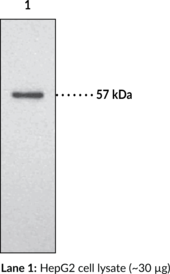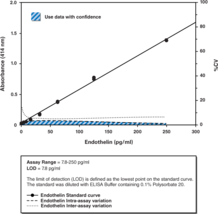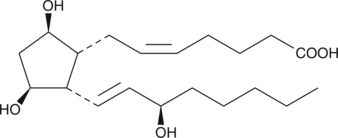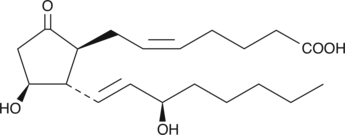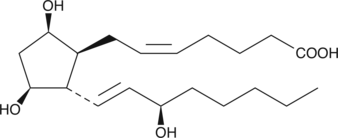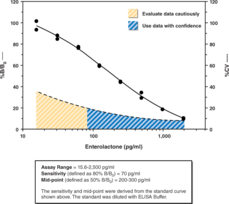Cayman
Showing 19651–19800 of 45550 results
-
Endothall is an herbicide that is used to control a wide range of terrestrial and aquatic plants. It is a contact herbicide that inhibits translation and induces the production of ethylene in some plants.{30172,30171} Endothall has a half-life of approximately four days in experimental pools.{30173}
Brand:CaymanSKU:-Available on backorder
Immunogen: Synthetic peptide from the N-terminal region of human endothelial lipase • Host: Rabbit • Species Reactivity: (+) Human, mouse, ovine, porcine, and rat • Application(s): IHC and WB • EL is a major genetic determinant for the concentration, structure, and metabolism of HDL, which protects against atherosclerosis
Brand:CaymanSKU:100030- 500 µlAvailable on backorder
Immunogen: Synthetic peptide from the N-terminal region of human endothelial lipase • Host: Rabbit • Species Reactivity: (+) Human, mouse, ovine, porcine, and rat • Application(s): IHC and WB • EL is a major genetic determinant for the concentration, structure, and metabolism of HDL, which protects against atherosclerosis
Brand:CaymanSKU:100030- 500 µlEndothelial lipase (EL) is a major genetic determinant for the concentration, structure, and metabolism of high-density lipoprotein, which protects against atherosclerosis.{11500, 11501} It was originally cloned from endothelial cells and found to be expressed in a distinct and complementary tissue-restricted fashion, with high-level expression in the liver, placenta, lung, ovary, and macrophage.{11293} Immunohistochemical studies demonstrate that EL is expressed in infiltrating cells such as macrophages within atheromatous plaques, in addition to endothelial and smooth muscle cells in non-atherosclerotic coronary arteries. Furthermore, EL expression is detected in the neovasculature within atheromatous plaques in atherosclerotic coronary arteries, indicating that EL may have unique functional roles in atherosclerosis.{11499} Cayman Chemical’s EL polyclonal antibody can be used for western blot and immunohistochemical analysis for EL on samples of human, murine, rat, porcine, and ovine origin. Other applications for use of this antibody have not yet been tested.
Brand:CaymanSKU:100030 - 500 µlAvailable on backorder
The endothelin peptide family consists of three isoforms, ET-1 (corresponding to the initially isolated and most predominant isoform), ET-2, and ET-3. ET-1 is a 21 amino acid peptide and is one of the most potent vasoconstritors currently known. ET-2 displays similar pharmacology to ET-1, whereas ET-3 is a weak vasoconstrictor but more potent inhibitor of platelet aggregation. Cayman’s Endothelin Assay is an immunometric (i.e., sandwich) ELISA that permits endothelin measurements within the range of 7.8-250 pg/ml, typically with a limit of detection of 7.8 pg/ml. Inter- and intra-assay CV’s of less than 10% may be achieved at most concentrations. This assay offers sensitive and specific analysis of endothelin in serum, plasma, urine, or cell culture media.
Brand:CaymanSKU:583151 - 480 wellsAvailable on backorder
The endothelin peptide family consists of three isoforms, ET-1 (corresponding to the initially isolated and most predominant isoform), ET-2, and ET-3. ET-1 is a 21 amino acid peptide and is one of the most potent vasoconstritors currently known. ET-2 displays similar pharmacology to ET-1, whereas ET-3 is a weak vasoconstrictor but more potent inhibitor of platelet aggregation. Cayman’s Endothelin Assay is an immunometric (i.e., sandwich) ELISA that permits endothelin measurements within the range of 7.8-250 pg/ml, typically with a limit of detection of 7.8 pg/ml. Inter- and intra-assay CV’s of less than 10% may be achieved at most concentrations. This assay offers sensitive and specific analysis of endothelin in serum, plasma, urine, or cell culture media.
Brand:CaymanSKU:583151 - 96 wellsAvailable on backorder
Brand:CaymanSKU:483154 - 1 eaAvailable on backorder
Enfuvirtide is a biomimetic peptide inhibitor of HIV-1 fusion with CD4+ cells.{36579} It inhibits HIV-1 infectivity of HeLa cells stably expressing CD4 by the HXB2 strain (IC50 = 692 pM) and by clinical isolates (IC90s = 6.1-61 nM) in a single-cycle infectivity assay. It also inhibits genomic integration of HIV-1 into human intraepithelial vaginal cells and peripheral blood mononuclear cells (PBMCs; IC50s = 51.2 and 13.58 μM, respectively).{36580} Enfuvirtide binds to a recombinant molecular mimic of HIV-1 glycoprotein gp41 that contains three N-terminal heptad and two C-terminal heptad repeat regions (Kd = 32 nM).{36581} It also binds to recombinant formyl peptide receptors (FPR) expressed in rat basophilic leukemia cells (IC50 = 5 nM) and attracts and activates human peripheral blood phagocytes, but not T lymphocytes, in vitro when used at a concentration of 100 nM.{36582} Formulations containing enfuvirtide have been used in combination therapy for the treatment of HIV-1/AIDS.
Brand:CaymanSKU:24097 - 1 mgAvailable on backorder
Enfuvirtide is a biomimetic peptide inhibitor of HIV-1 fusion with CD4+ cells.{36579} It inhibits HIV-1 infectivity of HeLa cells stably expressing CD4 by the HXB2 strain (IC50 = 692 pM) and by clinical isolates (IC90s = 6.1-61 nM) in a single-cycle infectivity assay. It also inhibits genomic integration of HIV-1 into human intraepithelial vaginal cells and peripheral blood mononuclear cells (PBMCs; IC50s = 51.2 and 13.58 μM, respectively).{36580} Enfuvirtide binds to a recombinant molecular mimic of HIV-1 glycoprotein gp41 that contains three N-terminal heptad and two C-terminal heptad repeat regions (Kd = 32 nM).{36581} It also binds to recombinant formyl peptide receptors (FPR) expressed in rat basophilic leukemia cells (IC50 = 5 nM) and attracts and activates human peripheral blood phagocytes, but not T lymphocytes, in vitro when used at a concentration of 100 nM.{36582} Formulations containing enfuvirtide have been used in combination therapy for the treatment of HIV-1/AIDS.
Brand:CaymanSKU:24097 - 10 mgAvailable on backorder
Enfuvirtide is a biomimetic peptide inhibitor of HIV-1 fusion with CD4+ cells.{36579} It inhibits HIV-1 infectivity of HeLa cells stably expressing CD4 by the HXB2 strain (IC50 = 692 pM) and by clinical isolates (IC90s = 6.1-61 nM) in a single-cycle infectivity assay. It also inhibits genomic integration of HIV-1 into human intraepithelial vaginal cells and peripheral blood mononuclear cells (PBMCs; IC50s = 51.2 and 13.58 μM, respectively).{36580} Enfuvirtide binds to a recombinant molecular mimic of HIV-1 glycoprotein gp41 that contains three N-terminal heptad and two C-terminal heptad repeat regions (Kd = 32 nM).{36581} It also binds to recombinant formyl peptide receptors (FPR) expressed in rat basophilic leukemia cells (IC50 = 5 nM) and attracts and activates human peripheral blood phagocytes, but not T lymphocytes, in vitro when used at a concentration of 100 nM.{36582} Formulations containing enfuvirtide have been used in combination therapy for the treatment of HIV-1/AIDS.
Brand:CaymanSKU:24097 - 5 mgAvailable on backorder
Eniporide is a selective inhibitor of human Na+/H+ exchanger isoform 1 (NHE-1) (IC50 = 4.5 nM).{34581} Inhibition with eniporide prevents calcium overload-induced myocardial ischemia-reperfusion injury in vitro and in vivo.{34582,22706,34583,34584}
Brand:CaymanSKU:20984 -Out of stock
Eniporide is a selective inhibitor of human Na+/H+ exchanger isoform 1 (NHE-1) (IC50 = 4.5 nM).{34581} Inhibition with eniporide prevents calcium overload-induced myocardial ischemia-reperfusion injury in vitro and in vivo.{34582,22706,34583,34584}
Brand:CaymanSKU:20984 -Out of stock
Eniporide is a selective inhibitor of human Na+/H+ exchanger isoform 1 (NHE-1) (IC50 = 4.5 nM).{34581} Inhibition with eniporide prevents calcium overload-induced myocardial ischemia-reperfusion injury in vitro and in vivo.{34582,22706,34583,34584}
Brand:CaymanSKU:20984 -Out of stock
Eniporide is a selective inhibitor of human Na+/H+ exchanger isoform 1 (NHE-1) (IC50 = 4.5 nM).{34581} Inhibition with eniporide prevents calcium overload-induced myocardial ischemia-reperfusion injury in vitro and in vivo.{34582,22706,34583,34584}
Brand:CaymanSKU:20984 -Out of stock
ENMD-2076 is a multi-kinase inhibitor that inhibits FMS-related tyrosine kinase 3 (FLT3), RET, and Aurora A kinase with IC50 values of 1.86, 10.4, and 14 nM, respectively.{39604} It inhibits additional kinases involved in angiogenesis such as VEGFR3, PDGFRα, and FGFR2, among others, with IC50 values of less than 100 nM. It inhibits proliferation of several human triple-negative breast cancer (TNBC) cell lines with IC50 values of less than 1 µM, halts the cell cycle at the G2 phase, and induces apoptosis.{39603} Oral administration of ENMD-2076 (200 mg/kg), reduces proliferation, enhances p53- and p73-mediated cancer cell apoptosis and senescence, and inhibits growth of sensitive primary tumors in a TNBC mouse xenograft model.{39605} It also decreases tumor vascular permeability and perfusion and inhibits tumor growth in human TNBC and colorectal cancer mouse xenograft models when administered orally at a dose of 100 mg/kg.{39603,39606}
Brand:CaymanSKU:22956 - 1 mgAvailable on backorder
ENMD-2076 is a multi-kinase inhibitor that inhibits FMS-related tyrosine kinase 3 (FLT3), RET, and Aurora A kinase with IC50 values of 1.86, 10.4, and 14 nM, respectively.{39604} It inhibits additional kinases involved in angiogenesis such as VEGFR3, PDGFRα, and FGFR2, among others, with IC50 values of less than 100 nM. It inhibits proliferation of several human triple-negative breast cancer (TNBC) cell lines with IC50 values of less than 1 µM, halts the cell cycle at the G2 phase, and induces apoptosis.{39603} Oral administration of ENMD-2076 (200 mg/kg), reduces proliferation, enhances p53- and p73-mediated cancer cell apoptosis and senescence, and inhibits growth of sensitive primary tumors in a TNBC mouse xenograft model.{39605} It also decreases tumor vascular permeability and perfusion and inhibits tumor growth in human TNBC and colorectal cancer mouse xenograft models when administered orally at a dose of 100 mg/kg.{39603,39606}
Brand:CaymanSKU:22956 - 10 mgAvailable on backorder
ENMD-2076 is a multi-kinase inhibitor that inhibits FMS-related tyrosine kinase 3 (FLT3), RET, and Aurora A kinase with IC50 values of 1.86, 10.4, and 14 nM, respectively.{39604} It inhibits additional kinases involved in angiogenesis such as VEGFR3, PDGFRα, and FGFR2, among others, with IC50 values of less than 100 nM. It inhibits proliferation of several human triple-negative breast cancer (TNBC) cell lines with IC50 values of less than 1 µM, halts the cell cycle at the G2 phase, and induces apoptosis.{39603} Oral administration of ENMD-2076 (200 mg/kg), reduces proliferation, enhances p53- and p73-mediated cancer cell apoptosis and senescence, and inhibits growth of sensitive primary tumors in a TNBC mouse xenograft model.{39605} It also decreases tumor vascular permeability and perfusion and inhibits tumor growth in human TNBC and colorectal cancer mouse xenograft models when administered orally at a dose of 100 mg/kg.{39603,39606}
Brand:CaymanSKU:22956 - 5 mgAvailable on backorder
Enniatins are cyclohexadepsipeptides commonly isolated from fungi that are known to have antibiotic properties and to induce apoptosis in several cancer lines.{24952} Many function as ionophores, forming pores in cellular membranes to allow selective ion transport.{24952,24954} Enniatin A is one of four major analogs in the enniatin complex (Item No. 9002040). It has been shown to moderately inhibit acyl-CoA:cholesterol acyltranferase activity in rat liver microsomes with an IC50 value of 22 µM.{24950} Enniatin A also demonstrates anthelmintic properties against N. brasiliensis, T. spiralis, and H. spumosa.{24952}
Brand:CaymanSKU:-Available on backorder
Enniatins are cyclohexadepsipeptides commonly isolated from fungi that are known to have antibiotic properties and to induce apoptosis in several cancer lines.{24952} Many function as ionophores, forming pores in cellular membranes to allow selective ion transport.{24952,24954} Enniatin A is one of four major analogs in the enniatin complex (Item No. 9002040). It has been shown to moderately inhibit acyl-CoA:cholesterol acyltranferase activity in rat liver microsomes with an IC50 value of 22 µM.{24950} Enniatin A also demonstrates anthelmintic properties against N. brasiliensis, T. spiralis, and H. spumosa.{24952}
Brand:CaymanSKU:-Available on backorder
Enniatins are cyclohexadepsipeptides commonly isolated from fungi that are known to have antibiotic properties and to induce apoptosis in several cancer lines.{24952} Many function as ionophores, forming pores in cellular membranes to allow selective ion transport.{24952,24954} Enniatin A1 is one of four major analogs in the enniatin complex (Item No. 9002040 class). Its ionophoric activity has been described.{24954} Additionally, enniatin A1 has been found to induce apoptosis in cancer cells (EC50 = 5 µM in H4IIE rat hepatoma cells), decreasing the activation of the cell proliferation kinase, ERK (p44/p42) and inhibiting TNF-α-induced NF-κB activation.{24949}
Brand:CaymanSKU:-Available on backorder
Enniatins are cyclohexadepsipeptides commonly isolated from fungi that are known to have antibiotic properties and to induce apoptosis in several cancer lines.{24952} Many function as ionophores, forming pores in cellular membranes to allow selective ion transport.{24952,24954} Enniatin A1 is one of four major analogs in the enniatin complex (Item No. 9002040 class). Its ionophoric activity has been described.{24954} Additionally, enniatin A1 has been found to induce apoptosis in cancer cells (EC50 = 5 µM in H4IIE rat hepatoma cells), decreasing the activation of the cell proliferation kinase, ERK (p44/p42) and inhibiting TNF-α-induced NF-κB activation.{24949}
Brand:CaymanSKU:-Available on backorder
Enniatins are cyclichexadepsipeptides commonly isolated from fungi. Many act as ionophores, forming pores in cellular membranes to allow selective ion transport.{24952} Enniatin B is a relatively poor ionophore with some capacity to facilitate import of K+ and Na+ across membranes.{24954} It inhibits the pleiotropic drug resistance protein 5 (Pdr5p) in yeast.{24951} Through this mechanism enniatin B, at concentrations as low as 0.8 μM, augments the ability of cerulenin (Item No. 10005647) or cycloheximide (Item No. 14126) to impair cell proliferation in cells overexpressing Pdr5p, an effect that is not observed in cells lacking Pdr5p.{24951} Like other enniatins, enniatin B inhibits acyl-CoA: cholesterol acyltransferase (IC50 = 113 μM), blocking cholesteryl ester formation.{24950} Enniatin B (1 μM) also increases caspase activity and induces apoptosis in H4IIE hepatoma cells and, when mixed with other enniatins, alters p53 signaling in human cancer cells.{24949,24953}
Brand:CaymanSKU:-Enniatins are cyclichexadepsipeptides commonly isolated from fungi. Many act as ionophores, forming pores in cellular membranes to allow selective ion transport.{24952} Enniatin B is a relatively poor ionophore with some capacity to facilitate import of K+ and Na+ across membranes.{24954} It inhibits the pleiotropic drug resistance protein 5 (Pdr5p) in yeast.{24951} Through this mechanism enniatin B, at concentrations as low as 0.8 μM, augments the ability of cerulenin (Item No. 10005647) or cycloheximide (Item No. 14126) to impair cell proliferation in cells overexpressing Pdr5p, an effect that is not observed in cells lacking Pdr5p.{24951} Like other enniatins, enniatin B inhibits acyl-CoA: cholesterol acyltransferase (IC50 = 113 μM), blocking cholesteryl ester formation.{24950} Enniatin B (1 μM) also increases caspase activity and induces apoptosis in H4IIE hepatoma cells and, when mixed with other enniatins, alters p53 signaling in human cancer cells.{24949,24953}
Brand:CaymanSKU:-Enniatins are cyclohexadepsipeptides commonly isolated from fungi and are known to have antibiotic properties. Many act as ionophores, forming pores in cellular membranes to allow selective ion transport.{24952,24954} Enniatin B1 is one of four major analogs of the enniatin complex (Item No. 9002040). It has been shown to induce apoptosis in several cancer lines (EC50s ≤ 10 µM) and to decrease the activation of the cell proliferation kinase, ERK (p44/p42).{24949} Enniatin B1 also inhibits the multi-drug resistance transporter Pdr5p from S. cerevisiae and has been used to examine drug resistance mechanisms.{24951}
Brand:CaymanSKU:-Out of stock
Enniatins are cyclohexadepsipeptides commonly isolated from fungi and are known to have antibiotic properties. Many act as ionophores, forming pores in cellular membranes to allow selective ion transport.{24952,24954} Enniatin B1 is one of four major analogs of the enniatin complex (Item No. 9002040). It has been shown to induce apoptosis in several cancer lines (EC50s ≤ 10 µM) and to decrease the activation of the cell proliferation kinase, ERK (p44/p42).{24949} Enniatin B1 also inhibits the multi-drug resistance transporter Pdr5p from S. cerevisiae and has been used to examine drug resistance mechanisms.{24951}
Brand:CaymanSKU:-Out of stock
Enniatin complex is a mixture of cyclohexadepsipeptides, commonly isolated from fungi, that act as ionophores, forming pores in cellular membranes to allow selective ion transport.{24952,24954} The complex typically contains the major components: A (Item No. 17456), A1 (Item No. 17457), B (Item No. 15382), and B1 (Item No. 17245) together with minor amounts of enniatin C, D, E, and F.{24952} Enniatins exhibit antimicrobial activity against a variety of eukaryotic and prokaryotic genera, inhibit acyl-CoA:cholesterol acyltranferase, and induce apoptosis in several cancer lines.{24952,24950,24949,24953,24951}
Brand:CaymanSKU:9002040 - 10 mgAvailable on backorder
Enniatin complex is a mixture of cyclohexadepsipeptides, commonly isolated from fungi, that act as ionophores, forming pores in cellular membranes to allow selective ion transport.{24952,24954} The complex typically contains the major components: A (Item No. 17456), A1 (Item No. 17457), B (Item No. 15382), and B1 (Item No. 17245) together with minor amounts of enniatin C, D, E, and F.{24952} Enniatins exhibit antimicrobial activity against a variety of eukaryotic and prokaryotic genera, inhibit acyl-CoA:cholesterol acyltranferase, and induce apoptosis in several cancer lines.{24952,24950,24949,24953,24951}
Brand:CaymanSKU:9002040 - 50 mgAvailable on backorder
Enopeptin A, originally isolated from a culture broth of Streptomyces sp. RK-1051, is a depsipeptide antibiotic that contains two unusual amino acids (N-methylalanine and 4-methylproline) and features a pentaenone side chain.{27772,27773} It is effective against Gram-positive bacteria, including methicillin-resistant S. aureus (MIC = 25 µg/ml), and Gram-negative bacteria, including mutant forms of E. coli and P. aeruginosa (MICs = 200 µg/ml); however, it is not inhibitory to fungi.{27772}
Brand:CaymanSKU:-Out of stock
Enopeptin A, originally isolated from a culture broth of Streptomyces sp. RK-1051, is a depsipeptide antibiotic that contains two unusual amino acids (N-methylalanine and 4-methylproline) and features a pentaenone side chain.{27772,27773} It is effective against Gram-positive bacteria, including methicillin-resistant S. aureus (MIC = 25 µg/ml), and Gram-negative bacteria, including mutant forms of E. coli and P. aeruginosa (MICs = 200 µg/ml); however, it is not inhibitory to fungi.{27772}
Brand:CaymanSKU:-Out of stock
Enoxacin is a fluoroquinolone that prevents bacterial growth by interfering with DNA replication, inhibiting bacterial DNA gyrase (IC50 = 126 µg/ml) and topoisomerase IV (IC50 = 26.5 µg/ml).{27493} It demonstrates broad-spectrum antibacterial activity against many Gram-positive and Gram-negative bacteria.{27493} Its ability to bind to TAR RNA-binding protein 2, a microRNA biosynthesis protein, has been used to enhance the production of microRNAs with tumor suppressor functions to generate tumor-specific growth inhibitory effects in cancer models.{27668}
Brand:CaymanSKU:-Out of stock
Enoxacin is a fluoroquinolone that prevents bacterial growth by interfering with DNA replication, inhibiting bacterial DNA gyrase (IC50 = 126 µg/ml) and topoisomerase IV (IC50 = 26.5 µg/ml).{27493} It demonstrates broad-spectrum antibacterial activity against many Gram-positive and Gram-negative bacteria.{27493} Its ability to bind to TAR RNA-binding protein 2, a microRNA biosynthesis protein, has been used to enhance the production of microRNAs with tumor suppressor functions to generate tumor-specific growth inhibitory effects in cancer models.{27668}
Brand:CaymanSKU:-Out of stock
Enoxacin is a fluoroquinolone that prevents bacterial growth by interfering with DNA replication, inhibiting bacterial DNA gyrase (IC50 = 126 µg/ml) and topoisomerase IV (IC50 = 26.5 µg/ml).{27493} It demonstrates broad-spectrum antibacterial activity against many Gram-positive and Gram-negative bacteria.{27493} Its ability to bind to TAR RNA-binding protein 2, a microRNA biosynthesis protein, has been used to enhance the production of microRNAs with tumor suppressor functions to generate tumor-specific growth inhibitory effects in cancer models.{27668}
Brand:CaymanSKU:-Out of stock
Enoximone is a phosphodiesterase 3 (PDE3) inhibitor (IC50 = 5.9 µM).{56134} It is selective for PDE3 over PDE1, -2, and -4 (IC50s = 2,100, 2,900, and 21.1 µM, respectively). Enoximone increases the force of contraction and cAMP levels in isolated canine right ventricular trabeculae, an effect that can be reversed by carbamoylcholine (carbachol; Item No. 14486).{56135} In vivo, enoximone (0.1-1 mg/kg) increases cardiac contractile force in dogs.{56136} Formulations containing enoximone have been used in the treatment of congestive heart failure.
Brand:CaymanSKU:30868 - 1 mgAvailable on backorder
Enoximone is a phosphodiesterase 3 (PDE3) inhibitor (IC50 = 5.9 µM).{56134} It is selective for PDE3 over PDE1, -2, and -4 (IC50s = 2,100, 2,900, and 21.1 µM, respectively). Enoximone increases the force of contraction and cAMP levels in isolated canine right ventricular trabeculae, an effect that can be reversed by carbamoylcholine (carbachol; Item No. 14486).{56135} In vivo, enoximone (0.1-1 mg/kg) increases cardiac contractile force in dogs.{56136} Formulations containing enoximone have been used in the treatment of congestive heart failure.
Brand:CaymanSKU:30868 - 10 mgAvailable on backorder
Enoximone is a phosphodiesterase 3 (PDE3) inhibitor (IC50 = 5.9 µM).{56134} It is selective for PDE3 over PDE1, -2, and -4 (IC50s = 2,100, 2,900, and 21.1 µM, respectively). Enoximone increases the force of contraction and cAMP levels in isolated canine right ventricular trabeculae, an effect that can be reversed by carbamoylcholine (carbachol; Item No. 14486).{56135} In vivo, enoximone (0.1-1 mg/kg) increases cardiac contractile force in dogs.{56136} Formulations containing enoximone have been used in the treatment of congestive heart failure.
Brand:CaymanSKU:30868 - 5 mgAvailable on backorder
ENPP1 inhibitor C is an inhibitor of ectonucleotide pyrophosphatase/phosphodiesterase 1 (ENPP1; IC50 = 0.26 µM in a cell-free assay).{50634} It is selective for ENPP1 over ENPP2-7 at 10 µM. ENPP1 inhibitor C decreases ENPP1 activity in MDA-MB-231 human breast and C6 rat glioma cancer cells when used at a concentration of 10 µM.
Brand:CaymanSKU:29809 - 1 mgAvailable on backorder
ENPP1 inhibitor C is an inhibitor of ectonucleotide pyrophosphatase/phosphodiesterase 1 (ENPP1; IC50 = 0.26 µM in a cell-free assay).{50634} It is selective for ENPP1 over ENPP2-7 at 10 µM. ENPP1 inhibitor C decreases ENPP1 activity in MDA-MB-231 human breast and C6 rat glioma cancer cells when used at a concentration of 10 µM.
Brand:CaymanSKU:29809 - 10 mgAvailable on backorder
ENPP1 inhibitor C is an inhibitor of ectonucleotide pyrophosphatase/phosphodiesterase 1 (ENPP1; IC50 = 0.26 µM in a cell-free assay).{50634} It is selective for ENPP1 over ENPP2-7 at 10 µM. ENPP1 inhibitor C decreases ENPP1 activity in MDA-MB-231 human breast and C6 rat glioma cancer cells when used at a concentration of 10 µM.
Brand:CaymanSKU:29809 - 25 mgAvailable on backorder
ENPP1 inhibitor C is an inhibitor of ectonucleotide pyrophosphatase/phosphodiesterase 1 (ENPP1; IC50 = 0.26 µM in a cell-free assay).{50634} It is selective for ENPP1 over ENPP2-7 at 10 µM. ENPP1 inhibitor C decreases ENPP1 activity in MDA-MB-231 human breast and C6 rat glioma cancer cells when used at a concentration of 10 µM.
Brand:CaymanSKU:29809 - 5 mgAvailable on backorder
ENPP1-IN-1 is an inhibitor of ectonucleotide pyrophosphatase/phosphodiesterase 1 (ENPP1).{54557} It inhibits the hydrolysis of 2’3’-cGAMP (Item No. 19887) and the ATP analog p-nitrophenyl 5’-adenosine monophosphate (AMP-pNP; Kis = ≤100 and 100-1,000 nM, respectively, in enzyme assays). ENPP1-IN-1 enhances transcription of the gene encoding IFN-β in 2’3’-cGAMP-stimulated human foreskin fibroblast cells (HFF-1) in a concentration-dependent manner.
Brand:CaymanSKU:31764 - 10 mgAvailable on backorder
ENPP1-IN-1 is an inhibitor of ectonucleotide pyrophosphatase/phosphodiesterase 1 (ENPP1).{54557} It inhibits the hydrolysis of 2’3’-cGAMP (Item No. 19887) and the ATP analog p-nitrophenyl 5’-adenosine monophosphate (AMP-pNP; Kis = ≤100 and 100-1,000 nM, respectively, in enzyme assays). ENPP1-IN-1 enhances transcription of the gene encoding IFN-β in 2’3’-cGAMP-stimulated human foreskin fibroblast cells (HFF-1) in a concentration-dependent manner.
Brand:CaymanSKU:31764 - 25 mgAvailable on backorder
ENPP1-IN-1 is an inhibitor of ectonucleotide pyrophosphatase/phosphodiesterase 1 (ENPP1).{54557} It inhibits the hydrolysis of 2’3’-cGAMP (Item No. 19887) and the ATP analog p-nitrophenyl 5’-adenosine monophosphate (AMP-pNP; Kis = ≤100 and 100-1,000 nM, respectively, in enzyme assays). ENPP1-IN-1 enhances transcription of the gene encoding IFN-β in 2’3’-cGAMP-stimulated human foreskin fibroblast cells (HFF-1) in a concentration-dependent manner.
Brand:CaymanSKU:31764 - 5 mgAvailable on backorder
ENPP1-IN-1 is an inhibitor of ectonucleotide pyrophosphatase/phosphodiesterase 1 (ENPP1).{54557} It inhibits the hydrolysis of 2’3’-cGAMP (Item No. 19887) and the ATP analog p-nitrophenyl 5’-adenosine monophosphate (AMP-pNP; Kis = ≤100 and 100-1,000 nM, respectively, in enzyme assays). ENPP1-IN-1 enhances transcription of the gene encoding IFN-β in 2’3’-cGAMP-stimulated human foreskin fibroblast cells (HFF-1) in a concentration-dependent manner.
Brand:CaymanSKU:31764 - 50 mgAvailable on backorder
Enrofloxacin is a broad-spectrum fluoroquinolone antibiotic that is used primarily in veterinary medicine.{32425,32426} It inhibits bacterial DNA gyrase.{32427} Enrofloxacin displays high bioavailability in most species and rapid absorption after oral, intramuscular, or subcutaneous administration.{32426} It has broad distribution in the animal, excellent tissue penetration, and a long serum half-life.{32426}
Brand:CaymanSKU:20301 -Available on backorder
Enrofloxacin is a broad-spectrum fluoroquinolone antibiotic that is used primarily in veterinary medicine.{32425,32426} It inhibits bacterial DNA gyrase.{32427} Enrofloxacin displays high bioavailability in most species and rapid absorption after oral, intramuscular, or subcutaneous administration.{32426} It has broad distribution in the animal, excellent tissue penetration, and a long serum half-life.{32426}
Brand:CaymanSKU:20301 -Available on backorder
Enrofloxacin is a broad-spectrum fluoroquinolone antibiotic that is used primarily in veterinary medicine.{32425,32426} It inhibits bacterial DNA gyrase.{32427} Enrofloxacin displays high bioavailability in most species and rapid absorption after oral, intramuscular, or subcutaneous administration.{32426} It has broad distribution in the animal, excellent tissue penetration, and a long serum half-life.{32426}
Brand:CaymanSKU:20301 -Available on backorder
Enrofloxacin is a broad-spectrum fluoroquinolone antibiotic that is used primarily in veterinary medicine.{32425,32426} It inhibits bacterial DNA gyrase.{32427} Enrofloxacin displays high bioavailability in most species and rapid absorption after oral, intramuscular, or subcutaneous administration.{32426} It has broad distribution in the animal, excellent tissue penetration, and a long serum half-life.{32426}
Brand:CaymanSKU:20301 -Available on backorder
Ensartinib is a potent and selective inhibitor of anaplastic lymphoma kinase (ALK; IC50 50 = 15 nM) but has no effect on cell growth driven by other mutant kinases or that of non-cancerous HepG2 cells. Ensartinib, at a dose of 25 mg/kg, reduces H3122 xenograft growth with no effect on body weight in nude mice. It is also brain-permeable to a concentration of 65 nM. Formulations containing ensartinib are being used to treat non-small cell lung cancer in Phase I/II clinical trials.{29756}
Brand:CaymanSKU:21341 -Out of stock
Ensartinib is a potent and selective inhibitor of anaplastic lymphoma kinase (ALK; IC50 50 = 15 nM) but has no effect on cell growth driven by other mutant kinases or that of non-cancerous HepG2 cells. Ensartinib, at a dose of 25 mg/kg, reduces H3122 xenograft growth with no effect on body weight in nude mice. It is also brain-permeable to a concentration of 65 nM. Formulations containing ensartinib are being used to treat non-small cell lung cancer in Phase I/II clinical trials.{29756}
Brand:CaymanSKU:21341 -Out of stock
Ensartinib is a potent and selective inhibitor of anaplastic lymphoma kinase (ALK; IC50 50 = 15 nM) but has no effect on cell growth driven by other mutant kinases or that of non-cancerous HepG2 cells. Ensartinib, at a dose of 25 mg/kg, reduces H3122 xenograft growth with no effect on body weight in nude mice. It is also brain-permeable to a concentration of 65 nM. Formulations containing ensartinib are being used to treat non-small cell lung cancer in Phase I/II clinical trials.{29756}
Brand:CaymanSKU:21341 -Out of stock
Ensartinib is a potent and selective inhibitor of anaplastic lymphoma kinase (ALK; IC50 50 = 15 nM) but has no effect on cell growth driven by other mutant kinases or that of non-cancerous HepG2 cells. Ensartinib, at a dose of 25 mg/kg, reduces H3122 xenograft growth with no effect on body weight in nude mice. It is also brain-permeable to a concentration of 65 nM. Formulations containing ensartinib are being used to treat non-small cell lung cancer in Phase I/II clinical trials.{29756}
Brand:CaymanSKU:21341 -Out of stock
Isoprostanes are produced by the non-enzymatic, free radical peroxidation of arachidonic acid. They have been used as biomarkers of oxidative stress, but also have been found to have a potent biological activity. ent-8-iso Prostaglandin F2α (ent-8-iso PGF2α) is a potent vasoconstrictor of porcine retinal and brain microvessels with EC50 values of 31 and 54 nM, respectively.{14005}
Brand:CaymanSKU:10011545 - 100 µgAvailable on backorder
Isoprostanes are produced by the non-enzymatic, free radical peroxidation of arachidonic acid. They have been used as biomarkers of oxidative stress, but also have been found to have a potent biological activity. ent-8-iso Prostaglandin F2α (ent-8-iso PGF2α) is a potent vasoconstrictor of porcine retinal and brain microvessels with EC50 values of 31 and 54 nM, respectively.{14005}
Brand:CaymanSKU:10011545 - 25 µgAvailable on backorder
Isoprostanes are produced by the non-enzymatic, free radical peroxidation of arachidonic acid. They have been used as biomarkers of oxidative stress, but also have been found to have a potent biological activity. ent-8-iso Prostaglandin F2α (ent-8-iso PGF2α) is a potent vasoconstrictor of porcine retinal and brain microvessels with EC50 values of 31 and 54 nM, respectively.{14005}
Brand:CaymanSKU:10011545 - 50 µgAvailable on backorder
Isoprostanes are produced by the non-enzymatic, free radical peroxidation of phospholipid-esterified arachidonic acid. They have been used as biomarkers of oxidative stress, but they also have been found to have potent biological activity. ent-8-iso-15(S)-Prostaglandin F2α (ent-8-iso-15(S)-PGF2α) is a potent vasoconstrictor of porcine retinal and brain microvessels with EC50 values of 15 and 24 nM, respectively.{14005} This isoprostane is about ten-fold more potent than 8-iso-PGF2α in a whole blood platelet aggregation inhibition assay.{14928}
Brand:CaymanSKU:10010380 - 100 µgAvailable on backorder
Isoprostanes are produced by the non-enzymatic, free radical peroxidation of phospholipid-esterified arachidonic acid. They have been used as biomarkers of oxidative stress, but they also have been found to have potent biological activity. ent-8-iso-15(S)-Prostaglandin F2α (ent-8-iso-15(S)-PGF2α) is a potent vasoconstrictor of porcine retinal and brain microvessels with EC50 values of 15 and 24 nM, respectively.{14005} This isoprostane is about ten-fold more potent than 8-iso-PGF2α in a whole blood platelet aggregation inhibition assay.{14928}
Brand:CaymanSKU:10010380 - 25 µgAvailable on backorder
Isoprostanes are produced by the non-enzymatic, free radical peroxidation of phospholipid-esterified arachidonic acid. They have been used as biomarkers of oxidative stress, but they also have been found to have potent biological activity. ent-8-iso-15(S)-Prostaglandin F2α (ent-8-iso-15(S)-PGF2α) is a potent vasoconstrictor of porcine retinal and brain microvessels with EC50 values of 15 and 24 nM, respectively.{14005} This isoprostane is about ten-fold more potent than 8-iso-PGF2α in a whole blood platelet aggregation inhibition assay.{14928}
Brand:CaymanSKU:10010380 - 50 µgAvailable on backorder
Corey prostaglandin (PG)-lactone diol is a versatile, chiral intermediate used in the preparation of PGs and PG analogs. ent-Corey PG-lactone diol is the opposite enantiomer of corey PG-lactone diol.
Brand:CaymanSKU:10653 - 1 mgAvailable on backorder
Corey prostaglandin (PG)-lactone diol is a versatile, chiral intermediate used in the preparation of PGs and PG analogs. ent-Corey PG-lactone diol is the opposite enantiomer of corey PG-lactone diol.
Brand:CaymanSKU:10653 - 100 µgAvailable on backorder
Corey prostaglandin (PG)-lactone diol is a versatile, chiral intermediate used in the preparation of PGs and PG analogs. ent-Corey PG-lactone diol is the opposite enantiomer of corey PG-lactone diol.
Brand:CaymanSKU:10653 - 500 µgAvailable on backorder
Enzymatically-derived prostaglandin E2 (PGE2) is an optically pure compound whereas PGE2 derived from the free radical-catalyzed peroxidation of arachidonate is a racemic mixture. Ent-PGE2 is the opposite enantiomer of PGE2. Significant amounts of racemic PGE2 (rac-PGE2) are generated in vitro and in vivo in settings of oxidative stress via the isoprostane pathway. A proposed mechanism for the formation of rac-PGE2 involves the base catalyzed equilibration from 15-E2t-isoprostane (8-iso-PGE2), generated from the 15-H2t-isoprostane endoperoxide.{11213}
Brand:CaymanSKU:10008294 - 1 mgAvailable on backorder
Enzymatically-derived prostaglandin E2 (PGE2) is an optically pure compound whereas PGE2 derived from the free radical-catalyzed peroxidation of arachidonate is a racemic mixture. Ent-PGE2 is the opposite enantiomer of PGE2. Significant amounts of racemic PGE2 (rac-PGE2) are generated in vitro and in vivo in settings of oxidative stress via the isoprostane pathway. A proposed mechanism for the formation of rac-PGE2 involves the base catalyzed equilibration from 15-E2t-isoprostane (8-iso-PGE2), generated from the 15-H2t-isoprostane endoperoxide.{11213}
Brand:CaymanSKU:10008294 - 100 µgAvailable on backorder
Enzymatically-derived prostaglandin E2 (PGE2) is an optically pure compound whereas PGE2 derived from the free radical-catalyzed peroxidation of arachidonate is a racemic mixture. Ent-PGE2 is the opposite enantiomer of PGE2. Significant amounts of racemic PGE2 (rac-PGE2) are generated in vitro and in vivo in settings of oxidative stress via the isoprostane pathway. A proposed mechanism for the formation of rac-PGE2 involves the base catalyzed equilibration from 15-E2t-isoprostane (8-iso-PGE2), generated from the 15-H2t-isoprostane endoperoxide.{11213}
Brand:CaymanSKU:10008294 - 500 µgAvailable on backorder
Enzymatically-derived Prostaglandin F2α (PGF2α) is an optically pure compound whereas PGF2α derived from the free radical-catalyzed peroxidation of arachidonate is a racemic mixture. Ent-PGF2α is the opposite enantiomer of PGF2α. This compound can only be generated via the isoprostane pathway of free radical-catalyzed lipid peroxidation and has been implicated as a marker of oxidative stress. Levels of ent-PGF2α are elevated in human urine from heavy cigarette smokers and patients with hypercholesterolemia.{14667}
Brand:CaymanSKU:10008122 - 1 mgAvailable on backorder
Enzymatically-derived Prostaglandin F2α (PGF2α) is an optically pure compound whereas PGF2α derived from the free radical-catalyzed peroxidation of arachidonate is a racemic mixture. Ent-PGF2α is the opposite enantiomer of PGF2α. This compound can only be generated via the isoprostane pathway of free radical-catalyzed lipid peroxidation and has been implicated as a marker of oxidative stress. Levels of ent-PGF2α are elevated in human urine from heavy cigarette smokers and patients with hypercholesterolemia.{14667}
Brand:CaymanSKU:10008122 - 100 µgAvailable on backorder
Enzymatically-derived Prostaglandin F2α (PGF2α) is an optically pure compound whereas PGF2α derived from the free radical-catalyzed peroxidation of arachidonate is a racemic mixture. Ent-PGF2α is the opposite enantiomer of PGF2α. This compound can only be generated via the isoprostane pathway of free radical-catalyzed lipid peroxidation and has been implicated as a marker of oxidative stress. Levels of ent-PGF2α are elevated in human urine from heavy cigarette smokers and patients with hypercholesterolemia.{14667}
Brand:CaymanSKU:10008122 - 500 µgAvailable on backorder
Entacapone is a reversible catechol O-methyltransferase (COMT) inhibitor (IC50s = 10, 10, 20, and 160 nM for rat duodenum, brain, erythrocyte, and liver COMT, respectively).{42398} It is selective for COMT over monoamine oxidase A (MAO-A) and MAO-B and phenolsulphotransferase M (PST-M) and PST-P (IC50s = >50 µM). Entacapone (10 mg/kg), in combination with L-DOPA (Item No. 13248) and carbidopa (Item No. 23783), reduces 3-O-methyldopa (3-OMD) levels in the rat striatum and hypothalamus to 52 and 27%, respectively, of the levels in control animals receiving only L-DOPA and carbidopa.{22703} In a 6-OHDA rat model of Parkinson’s disease, entacapone (10 mg/kg), in combination with L-DOPA and benserazide (Item No. 20298), increases contralateral turning behavior and striatal extracellular dopamine levels.{42399} Entacapone also inhibits contraction of colon longitudinal muscle explants from a 6-OHDA rat model of Parkinson’s disease (EC50 = 200 µM).{42400} Formulations containing entacapone have been used in the treatment of Parkinson’s disease.
Brand:CaymanSKU:-Entacapone is a reversible catechol O-methyltransferase (COMT) inhibitor (IC50s = 10, 10, 20, and 160 nM for rat duodenum, brain, erythrocyte, and liver COMT, respectively).{42398} It is selective for COMT over monoamine oxidase A (MAO-A) and MAO-B and phenolsulphotransferase M (PST-M) and PST-P (IC50s = >50 µM). Entacapone (10 mg/kg), in combination with L-DOPA (Item No. 13248) and carbidopa (Item No. 23783), reduces 3-O-methyldopa (3-OMD) levels in the rat striatum and hypothalamus to 52 and 27%, respectively, of the levels in control animals receiving only L-DOPA and carbidopa.{22703} In a 6-OHDA rat model of Parkinson’s disease, entacapone (10 mg/kg), in combination with L-DOPA and benserazide (Item No. 20298), increases contralateral turning behavior and striatal extracellular dopamine levels.{42399} Entacapone also inhibits contraction of colon longitudinal muscle explants from a 6-OHDA rat model of Parkinson’s disease (EC50 = 200 µM).{42400} Formulations containing entacapone have been used in the treatment of Parkinson’s disease.
Brand:CaymanSKU:-Entacapone is a reversible catechol O-methyltransferase (COMT) inhibitor (IC50s = 10, 10, 20, and 160 nM for rat duodenum, brain, erythrocyte, and liver COMT, respectively).{42398} It is selective for COMT over monoamine oxidase A (MAO-A) and MAO-B and phenolsulphotransferase M (PST-M) and PST-P (IC50s = >50 µM). Entacapone (10 mg/kg), in combination with L-DOPA (Item No. 13248) and carbidopa (Item No. 23783), reduces 3-O-methyldopa (3-OMD) levels in the rat striatum and hypothalamus to 52 and 27%, respectively, of the levels in control animals receiving only L-DOPA and carbidopa.{22703} In a 6-OHDA rat model of Parkinson’s disease, entacapone (10 mg/kg), in combination with L-DOPA and benserazide (Item No. 20298), increases contralateral turning behavior and striatal extracellular dopamine levels.{42399} Entacapone also inhibits contraction of colon longitudinal muscle explants from a 6-OHDA rat model of Parkinson’s disease (EC50 = 200 µM).{42400} Formulations containing entacapone have been used in the treatment of Parkinson’s disease.
Brand:CaymanSKU:-Entacapone is a reversible catechol O-methyltransferase (COMT) inhibitor (IC50s = 10, 10, 20, and 160 nM for rat duodenum, brain, erythrocyte, and liver COMT, respectively).{42398} It is selective for COMT over monoamine oxidase A (MAO-A) and MAO-B and phenolsulphotransferase M (PST-M) and PST-P (IC50s = >50 µM). Entacapone (10 mg/kg), in combination with L-DOPA (Item No. 13248) and carbidopa (Item No. 23783), reduces 3-O-methyldopa (3-OMD) levels in the rat striatum and hypothalamus to 52 and 27%, respectively, of the levels in control animals receiving only L-DOPA and carbidopa.{22703} In a 6-OHDA rat model of Parkinson’s disease, entacapone (10 mg/kg), in combination with L-DOPA and benserazide (Item No. 20298), increases contralateral turning behavior and striatal extracellular dopamine levels.{42399} Entacapone also inhibits contraction of colon longitudinal muscle explants from a 6-OHDA rat model of Parkinson’s disease (EC50 = 200 µM).{42400} Formulations containing entacapone have been used in the treatment of Parkinson’s disease.
Brand:CaymanSKU:-Entacapone-d10 is intended for use as an internal standard for the quantification of entacapone (Item No. 14153) by GC- or LC-MS. Entacapone is a reversible catechol O-methyltransferase (COMT) inhibitor (IC50s = 10, 10, 20, and 160 nM for rat duodenum, brain, erythrocyte, and liver COMT, respectively).{42398} It is selective for COMT over monoamine oxidase A (MAO-A) and MAO-B and phenolsulphotransferase M (PST-M) and PST-P (IC50s = >50 µM). Entacapone (10 mg/kg), in combination with L-DOPA (Item No. 13248) and carbidopa (Item No. 23783), reduces 3-O-methyldopa (3-OMD) levels in the rat striatum and hypothalamus to 52 and 27%, respectively, of the levels in control animals receiving only L-DOPA and carbidopa.{22703} In a 6-OHDA rat model of Parkinson’s disease, entacapone (10 mg/kg), in combination with L-DOPA and benserazide (Item No. 20298), increases contralateral turning behavior and striatal extracellular dopamine levels.{42399} Entacapone also inhibits contraction of colon longitudinal muscle explants from a 6-OHDA rat model of Parkinson’s disease (EC50 = 200 µM).{42400} Formulations containing entacapone have been used in the treatment of Parkinson’s disease.
Brand:CaymanSKU:10010571 - 1 mgAvailable on backorder
Entacapone-d10 is intended for use as an internal standard for the quantification of entacapone (Item No. 14153) by GC- or LC-MS. Entacapone is a reversible catechol O-methyltransferase (COMT) inhibitor (IC50s = 10, 10, 20, and 160 nM for rat duodenum, brain, erythrocyte, and liver COMT, respectively).{42398} It is selective for COMT over monoamine oxidase A (MAO-A) and MAO-B and phenolsulphotransferase M (PST-M) and PST-P (IC50s = >50 µM). Entacapone (10 mg/kg), in combination with L-DOPA (Item No. 13248) and carbidopa (Item No. 23783), reduces 3-O-methyldopa (3-OMD) levels in the rat striatum and hypothalamus to 52 and 27%, respectively, of the levels in control animals receiving only L-DOPA and carbidopa.{22703} In a 6-OHDA rat model of Parkinson’s disease, entacapone (10 mg/kg), in combination with L-DOPA and benserazide (Item No. 20298), increases contralateral turning behavior and striatal extracellular dopamine levels.{42399} Entacapone also inhibits contraction of colon longitudinal muscle explants from a 6-OHDA rat model of Parkinson’s disease (EC50 = 200 µM).{42400} Formulations containing entacapone have been used in the treatment of Parkinson’s disease.
Brand:CaymanSKU:10010571 - 500 µgAvailable on backorder
Entecavir is an antiviral nucleoside analog of 2′-deoxyguanosine (Item No. 9002864) and inhibitor of hepatitis B virus (HBV) reverse transcriptase (IC50 = 0.5 nM).{22164,59703} It undergoes phosphorylation by cellular kinases to its active form, entecavir triphosphate.{53861,59703} Entecavir reduces virion DNA in the culture supernatant of HepG2/2.15 cells infected with hepatitis B virus (HBV; EC50 = 3.75 nM).{22164} It reduces serum and hepatic levels of viral DNA in a duckling model of HBV infection when administered at a dose of 1 mg/kg.{22166} Formulations containing entecavir have been used in the treatment of chronic HBV infection.
Brand:CaymanSKU:-Entecavir is an antiviral nucleoside analog of 2′-deoxyguanosine (Item No. 9002864) and inhibitor of hepatitis B virus (HBV) reverse transcriptase (IC50 = 0.5 nM).{22164,59703} It undergoes phosphorylation by cellular kinases to its active form, entecavir triphosphate.{53861,59703} Entecavir reduces virion DNA in the culture supernatant of HepG2/2.15 cells infected with hepatitis B virus (HBV; EC50 = 3.75 nM).{22164} It reduces serum and hepatic levels of viral DNA in a duckling model of HBV infection when administered at a dose of 1 mg/kg.{22166} Formulations containing entecavir have been used in the treatment of chronic HBV infection.
Brand:CaymanSKU:-Entecavir is an antiviral nucleoside analog of 2′-deoxyguanosine (Item No. 9002864) and inhibitor of hepatitis B virus (HBV) reverse transcriptase (IC50 = 0.5 nM).{22164,59703} It undergoes phosphorylation by cellular kinases to its active form, entecavir triphosphate.{53861,59703} Entecavir reduces virion DNA in the culture supernatant of HepG2/2.15 cells infected with hepatitis B virus (HBV; EC50 = 3.75 nM).{22164} It reduces serum and hepatic levels of viral DNA in a duckling model of HBV infection when administered at a dose of 1 mg/kg.{22166} Formulations containing entecavir have been used in the treatment of chronic HBV infection.
Brand:CaymanSKU:-Entecavir is an antiviral nucleoside analog of 2′-deoxyguanosine (Item No. 9002864) and inhibitor of hepatitis B virus (HBV) reverse transcriptase (IC50 = 0.5 nM).{22164,59703} It undergoes phosphorylation by cellular kinases to its active form, entecavir triphosphate.{53861,59703} Entecavir reduces virion DNA in the culture supernatant of HepG2/2.15 cells infected with hepatitis B virus (HBV; EC50 = 3.75 nM).{22164} It reduces serum and hepatic levels of viral DNA in a duckling model of HBV infection when administered at a dose of 1 mg/kg.{22166} Formulations containing entecavir have been used in the treatment of chronic HBV infection.
Brand:CaymanSKU:-Enterocin is an antibiotic originally isolated from Streptomyces sp. It has static activities against a broad range of Gram-positive and Gram-negative bacteria but has no activity against fungi, including yeasts.{32136} This natural product was named for its strong activity against Enterobacteriaceae and is not related to the large group of bacterial proteins isolated from Enterococci that are classified as bacteriocins.
Brand:CaymanSKU:20592 -Available on backorder
Enterocin is an antibiotic originally isolated from Streptomyces sp. It has static activities against a broad range of Gram-positive and Gram-negative bacteria but has no activity against fungi, including yeasts.{32136} This natural product was named for its strong activity against Enterobacteriaceae and is not related to the large group of bacterial proteins isolated from Enterococci that are classified as bacteriocins.
Brand:CaymanSKU:20592 -Available on backorder
Enterolactone is a mammalian lignan with an estrogen-like diphenolic structure. It is produced by intestinal bacteria from two plant precursors (matairesinol and secoisolariciresinol) obtained in the diet. Enterolactone and other lignans and phytoestrogens have been associated with a reduced risk of acute coronary events, hormone-dependent cancers, and possibly osteoporosis. Several studies have suggested that serum enterolactone may serve as a biomarker of a healthy, high-fiber diet. Cayman Chemical’s Enterolactone ELISA kit is a competitive assay that utilizes a standard curve ranging from 15.6-2,000 pg/ml. The assay has a range from 15.6-2,500 pg/ml and a sensitivity (80% B/B0) of approximately 70 pg/ml.
Brand:CaymanSKU:500520 - 480 solid wellsAvailable on backorder
Enterolactone is a mammalian lignan with an estrogen-like diphenolic structure. It is produced by intestinal bacteria from two plant precursors (matairesinol and secoisolariciresinol) obtained in the diet. Enterolactone and other lignans and phytoestrogens have been associated with a reduced risk of acute coronary events, hormone-dependent cancers, and possibly osteoporosis. Several studies have suggested that serum enterolactone may serve as a biomarker of a healthy, high-fiber diet. Cayman Chemical’s Enterolactone ELISA kit is a competitive assay that utilizes a standard curve ranging from 15.6-2,000 pg/ml. The assay has a range from 15.6-2,500 pg/ml and a sensitivity (80% B/B0) of approximately 70 pg/ml.
Brand:CaymanSKU:500520 - 480 strip wellsAvailable on backorder
Enterolactone is a mammalian lignan with an estrogen-like diphenolic structure. It is produced by intestinal bacteria from two plant precursors (matairesinol and secoisolariciresinol) obtained in the diet. Enterolactone and other lignans and phytoestrogens have been associated with a reduced risk of acute coronary events, hormone-dependent cancers, and possibly osteoporosis. Several studies have suggested that serum enterolactone may serve as a biomarker of a healthy, high-fiber diet. Cayman Chemical’s Enterolactone ELISA kit is a competitive assay that utilizes a standard curve ranging from 15.6-2,000 pg/ml. The assay has a range from 15.6-2,500 pg/ml and a sensitivity (80% B/B0) of approximately 70 pg/ml.
Brand:CaymanSKU:500520 - 96 solid wellsAvailable on backorder

